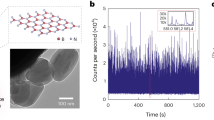Abstract
The discovery of Förster resonance energy transfer (FRET)1 has revolutionized our ability to measure inter- and intramolecular distances on the nanometre scale using fluorescence imaging. The phenomenon is based on electromagnetic-field-mediated energy transfer from an optically excited donor to an acceptor. We replace the acceptor molecule with a metallic film and use the measured energy transfer efficiency from donor molecules to metal surface plasmons2 to accurately deduce the distance between the molecules and metal. Like FRET, this makes it possible to localize emitters with nanometre accuracy, but the distance range over which efficient energy transfer takes place is an order of magnitude larger than for conventional FRET. This creates a new way to localize fluorescent entities on a molecular scale, over a distance range of more than 100 nm. We demonstrate the power of this method by profiling the basal lipid membrane of living cells.
This is a preview of subscription content, access via your institution
Access options
Subscribe to this journal
Receive 12 print issues and online access
$209.00 per year
only $17.42 per issue
Buy this article
- Purchase on Springer Link
- Instant access to full article PDF
Prices may be subject to local taxes which are calculated during checkout




Similar content being viewed by others
References
Förster, Th. Zwischenmolekulare energiewanderung und fluoreszenz. Ann. Phys. 437, 55–75 (1948).
Drexhage, K. H. Interaction of light with monomolecular dye layers. Prog. Opt. 12, 163–232 (1974).
Hell, S. W. Strategy for far-field optical imaging and writing without diffraction limit. Phys. Lett. A 326, 140–145 (2004).
Rust, M. J., Bates, M. & Zhuang, X. Sub-diffraction-limit imaging by stochastic optical reconstruction microscopy (STORM). Nature Methods 3, 793–795 (2006).
Betzig, E. et al. Imaging intracellular fluorescent proteins at nanometer resolution. Science 313, 1642–1645 (2006).
Hess, S. T., Girirajan, T. P. K. & Mason, M. D. Ultra-high resolution imaging by fluorescence photoactivation localization microscopy. Biophys. J. 91, 4258–4272 (2006).
Purcell, E. M. Spontaneous emission probabilities at radio frequencies. Phys. Rev. 69, 681 (1946).
Lukosz, W. & Kunz, R. E. Light emission by magnetic and electric dipoles close to a plane interface. I. Total radiated power. J. Opt. Soc. Am. 67, 1607–1615 (1977).
Chance, R. R., Prock, A. & Silbey, R. Molecular fluorescence and energy transfer near interfaces. Adv. Chem. Phys. 37, 1–65 (1978).
Colyer, R. A., Lee, C. & Gratton, E. A novel fluorescence lifetime imaging system that optimizes photon efficiency. Microsc. Res. Tech. 71, 201–213 (2008).
Chizhik, A. I. et al. Probing the radiative transition of single molecules with a tunable microresonator. Nano Lett. 11, 1700–1703 (2011).
Chizhik, A. I. et al. Electrodynamic coupling of electric dipole emitters to a fluctuating mode density within a nanocavity. Phys. Rev. Lett. 108, 163002 (2012).
Chizhik, A. I., Gregor, I. & Enderlein, J. Quantum yield measurement in a multicolor chromophore solution using a nanocavity. Nano Lett. 13, 1348–1351 (2013).
Enderlein, J. Single-molecule fluorescence near a metal layer. Chem. Phys. 247, 1–9 (1999).
Winckler, P., Jaffiol, R., Plain, J. & Royer, P. Nonradiative excitation fluorescence: probing volumes down to the attoliter range. J. Phys. Chem. Lett. 1, 2451–2454 (2010).
Berndt, M., Lorenz, M., Enderlein, J. & Diez, S. Axial nanometer distances measured by fluorescence lifetime imaging microscopy. Nano Lett. 10, 1497–1500 (2010).
Braun, D. & Fromherz, P. Fluorescence interferometry of neuronal cell adhesion on microstructured silicon. Phys. Rev. Lett. 81, 5241–5244 (1998).
Patra, D., Gregor, I. & Enderlein, J. Image analysis of defocused single-molecule images for three-dimensional molecule orientation studies. J. Phys. Chem. A 108, 6836–6841 (2004).
Heitmann, V., Reiss, B. & Wegener, J. The quartz crystal microbalance in cell biology: basics and applications. Chem. Sens. Biosens. 5, 303–338 (2007).
Acknowledgements
The authors thank the referees of this manuscript for enhancing the quality of the work. The authors also thank S. W. Hell for valuable advice. Financial support by the Deutsche Forschungsgemeinschaft is acknowledged (SFB 937, project A5, A14). A.I.C. also acknowledges financial support from the Alexander von Humboldt Foundation, and J.R. acknowledges financial support from the Boehringer Ingelheim Fonds.
Author information
Authors and Affiliations
Contributions
A.I.C., J.R., A.J. and J.E. conceived and designed the experiments. A.I.C. and J.R. performed the experiments. A.I.C., J.R. and J.E. analysed the data. A.I.C., J.R., I.G., A.J. and J.E. contributed materials/analysis tools. A.I.C., J.R., A.J. and J.E. wrote the paper.
Corresponding authors
Ethics declarations
Competing interests
The authors declare no competing financial interests.
Supplementary information
Supplementary information
Supplementary information (PDF 1007 kb)
Rights and permissions
About this article
Cite this article
Chizhik, A., Rother, J., Gregor, I. et al. Metal-induced energy transfer for live cell nanoscopy. Nature Photon 8, 124–127 (2014). https://doi.org/10.1038/nphoton.2013.345
Received:
Accepted:
Published:
Issue Date:
DOI: https://doi.org/10.1038/nphoton.2013.345
This article is cited by
-
Remodeling of the focal adhesion complex by hydrogen-peroxide-induced senescence
Scientific Reports (2023)
-
Fluorescence lifetime DNA-PAINT for multiplexed super-resolution imaging of cells
Communications Biology (2022)
-
Direct supercritical angle localization microscopy for nanometer 3D superresolution
Nature Communications (2021)
-
Large field-of-view nanometer-sectioning microscopy by using metal-induced energy transfer and biexponential lifetime analysis
Communications Biology (2021)
-
Graphene- and metal-induced energy transfer for single-molecule imaging and live-cell nanoscopy with (sub)-nanometer axial resolution
Nature Protocols (2021)



